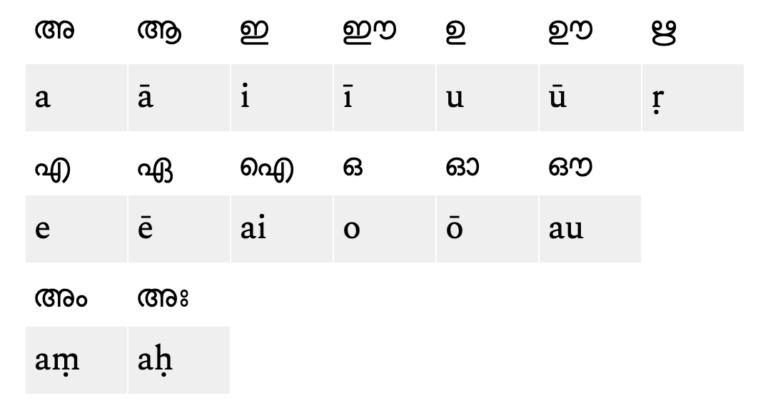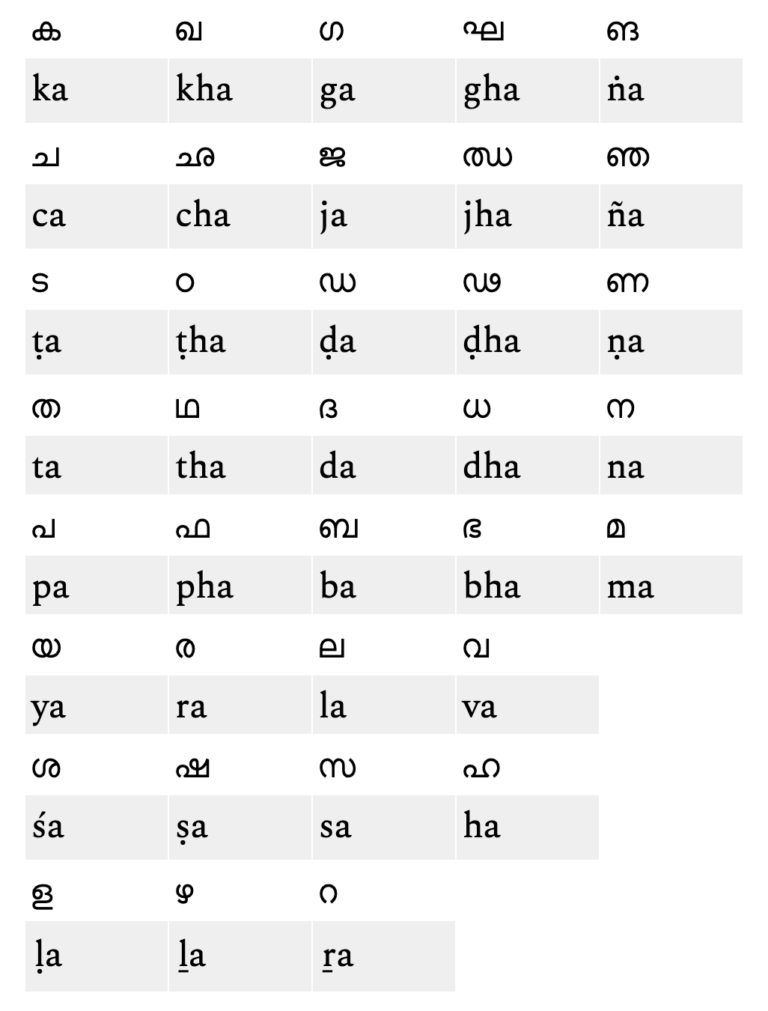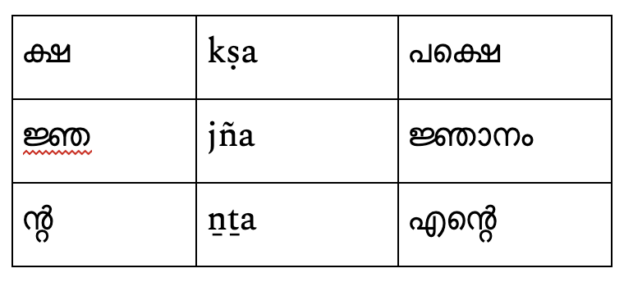For English speakers, the Malayalam sound system contains both familiar and unfamiliar sounds. The Malayalam written script is phonetic, meaning that you say it as you write it (mostly!), and syllabic, meaning that it’s based on an alphabet and the syllables you can make with an alphabet. Therefore, there is a good correspondence between written and spoken Malayalam, though colloquial speech often diverges from standard written forms. This guide summarizes the basic pronunciation of Malayalam letters and presumes that you have spent at least some time learning the basic written letters already. If you grew up speaking Malayalam or hearing it frequently, then this guide may not help your pronunciation much, but it may help you with spelling and a better understanding of the sound system.
Two things to recall about the Malayalam script. 1) If a vowel begins a word, you must use its initial vowel form. When a vowel occurs in the middle of a word, you must use its dependent vowel form. 2) Consonants always have an inherent a-sound, unless they are marked with a different dependent vowel or “cut off” with the special crescent sign.
Alphabetical order in Malayalam begins with the vowels and then the consonants.
Listen to the full alphabet of Malayalam and follow along in the tables:
Initial Vowels in Malayalam:

Basic Consonants in Malayalam:

Let’s take a closer look at the initial vowels first. Here are all the Malayalam vowels as they appear at the beginning of a word. The first row is the simple vowels, both short and long. The second row is the diphthongs, which combine two vowel sounds into one. The last row contains the special sounds called anusvāra and visarga that come from Sanskrit.
Simple Vowels (Row 1)
Diphthongs & Special Sounds (Rows 2 & 3)

As you can hear, in most cases, the difference between short and long vowel sounds is how long you linger on the sound (length). The quality of the vowel itself is the basically the same. However, two really important distinctions in vowel sounds are between അ/ആ and ഇ/ഈ. For these very common sounds, the difference is not length. Here’s a rough guide:
അ sounds like the u in but or hut
ആ sounds like the a in father or Amish
ഇ sounds like the i in bit or trip
ഈ sounds like the ea in eat or the first e in complete
The anusvāra അം is simply the way that a final m-sound is added to many words in Malayalam, especially those coming from Sanskrit. Visarga അഃ, on the other hand, is rather rare in Malayalam (unlike Sanskrit). In practice, it sounds like an extra bit of air expelled when saying the vowel (or, at the end of a word, like an echo of the last vowel sound).
Turning to consonants, remember that all Malayalam consonants have an inherent, unmarked a-sound. It is built into each basic consonant letter. To pronounce the consonants, therefore, we use this a-sound when reciting the alphabet.
Malayalam organizes its written alphabet much like Sanskrit and also includes all of the Sanskrit sounds. The pronunciation of each row moves from the back of the mouth to the front. The final three rows are, in order: the semivowels, the s-sounds (sibilants), and the special Tamil sounds. In theory, the pronunciation of the columns starts with “unvoiced” consonants (that do not make the vocal cords vibrate), then “voiced”, then “nasals” or n-sounds. Each unvoiced and voiced consonant also has an “aspirated” version, meaning that extra air is expelled when saying these letters. In practice, the first four columns all tend to collapse into the roughly the pronunciation of third column, when single and in the middle word (see the companion pronunciation guide for more details). To get started, listen to the recitation of these basic consonants and follow along in the table.








Most English speakers aspirate all their consonants a little bit and may, therefore, have some difficulty at first putting less and more air on them, as appropriate. The harder ones for most people are actually the unaspirated sounds, because they more closely approximate the consonant sounds of languages such as Spanish or Italian. If you can say, sí se puede (yes we can) correctly with very little air on the p and d, then you can say these Malayalam letters correctly.
American English speakers especially tend to say their ta-row sounds behind the teeth at the end of the palate (alveolar position). To adjust to Malayalam, push your tongue farther forward just under your front teeth to say the ത row and point the tip of the tongue toward the top of the head for the ട row. Listen to these contrasting pairs and example words using ta-row sounds.
തീ “fire” vs. ടീ “tea”
പതി “lord” vs. പറ്റി “about” vs. പടി “step”
Technically, the ശ sound is “palatal,” pronounced with tongue flat against the palate (same position as the ച row, while the ഷ sound is “retroflex,” tongue pointing to the top of the head (same as the ട row). In practice, mistakes in these two won’t matter much to native speakers. The English “sha” will get you close enough for both, but you will hear a slight difference, if you listen closely:
Finally, the special Tamil sounds. The letter ള is a retroflex l-sound—tongue pointing up. The letter റ is basically a retroflex r-sound, harsher than the letter ര, which is pronounced with the tongue just behind the teeth (alveolar). And, last of all is the pride of South India, the letter ഴ. Originating in Tamil, this sound is unique to the South Indian languages. To my ear, it is not so far from the deep American English r-sound in a word like scary or rate. The tip of the tongue curls back and may just touch the palate but the sound comes from around the sides of the tongue, unlike ള in which the sound comes over the tongue as it releases. Listen to some contrasting pairs and examples and then see if you can match the sounds.
ര vs. റ
ള vs. ഴ
In writing, putting consonants and vowels together requires using the dependent vowel signs for sounds other that short a. In theory, all the consonants above may be written with any vowel; in practice, some combinations don’t actually occur or are very rare. A syllable in Malayalam is a combination of a simple or conjunct consonant and a vowel, inherent or marked. The following table shows all vowels combined with the first three consonants. Note that one combination does not occur in practice.
Listen to the pronunciation of the syllables in this table. Pay close attention to the trickier sounds highlighted in : 1) short and long a, 2) short and long i, and 3) the ṛ-sound.


Doubled consonants are very frequent in Malayalam, for example: എനിക്ക്, കാപ്പി, പത്ത്, ആയിട്ട്, എന്ന്, അങ്ങനെ, and കണ്ണൻ. Letters from the ക and ങ (nasals) columns (not rows) above frequently double, though other letters may also double. Pronouncing these letters is mostly intuitive. For most letters, the sound is simply a “hard” version of the single version, hitting the consonant more crisply and/or lingering longer on it. For nasal sounds (the various n-sounds), lingering on the sound longer is key. It’s easiest to hear the difference between single and doubled consonants through contrastive pairs. Listen the following words with single and double versions of the same versions. Note how single consonants in the middle of a word become softer. Doubling makes them hard again.
An exceptional doubling occurs with the consonant റ. Instead of making an r-sound, double റ്റ make an alveolar t-sound, the usual American English t-sound!
The pronunciation of other conjunct consonants is easy and familiar to English speakers. So, the conjuncts in words such as വസ്ത്രം (vastraṃ), ഗ്ലാണം (glānaṃ), or വാക്യം (vākyaṃ) will be spoken as in English. However, several conjunct consonants build on your ability to articulate the new basic sounds in Malayalam. Here are some of the conjuncts that might pose problems for English speakers.


